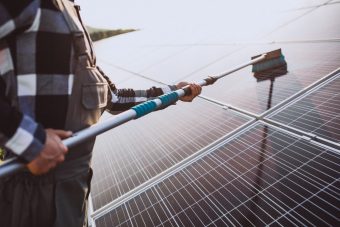
Dusty surfaces are a persistent phenomenon in our homes. And while they aesthetically disturb our space, these surfaces can also pose a problem for the operation of certain electrical and electronic devices, if large quantities of dust accumulate in or on them. Today there are various means of dust removal. I recently came across a liquid that prevents its accumulation. Dust is not only a challenge for homeowners but also for those who own solar panels or people who maintain solar power plants.
Dust negatively affects the efficiency of solar panels in two ways. Solar energy is produced thanks to the sun’s rays that fall on the photovoltaic modules and if they are covered with a layer of dust, it is difficult for the sun’s rays to reach directly and at full capacity. Less sun, less energy produced. However, I would like to highlight another problem here.
We have often talked bout what effect high air temperature has on the efficiency of solar energy. Some studies have shown that such temperatures can reduce efficiency by up to 25 per cent. Depending on the type of dust that ends up on the surface of the panel, it can lead to altered heat transfer patterns and create hot spots. How much negative impact the accumulation of dust will have depends on its shape, size and chemical properties.
We should take into account the geographical and climatic conditions of a certain area when analyzing the impact of dust. For instance, in parts of the world where rainfall is frequent and strong, solar panels will be naturally rinsed, while in desert areas a larger amount of dust naturally occurs, as precipitation is less frequent. Also, deserts are subject to more powerful storms, which additionally affect the distribution of dust. When installing panels in a specific location, local weather conditions, such as wind, should be taken into account. Solar panels should be oriented with these conditions in mind, while the accumulation of dust and its natural removal will depend on the slope.
At the same time as improving the performance of solar panels, solutions for their maintenance are also being developed. As a first example, I would like to mention special coatings, which protect the panel surface from dust accumulation.
Of course, we should never discard the human factor as there are people who are trained to maintain the cleanliness of solar panels with the help of special cleaning materials. However, technology has gone one step further. A device was designed that could be described as an improved version of a drone, which cleans almost independently. This drone has a camera that detects dirty surfaces, after which it descends on the panel and cleans it using a special robot that is attached to the drone.
Dust is not the only problem when it comes to solar panels, other natural phenomena such as falling leaves should also be considered. If we invest a bit more energy into finding solar panel maintenance solutions similar to the ones mentioned, we’ll get in return more green electricity, which is important for all of us.
Katarina Vuinac




